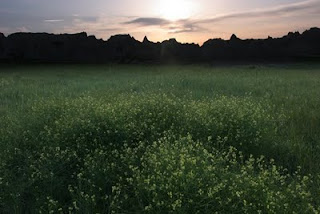I have had several people ask about what I do in post processing and why it is important. For me what you do with your image after the shutter has been opened is just as important as taking the initial image. Here is an image that I took in the southern part of the Bandlands in South Dakota. The first image is the straight Raw image without any conversion or enhancements. The next picture is the same image after Raw conversion and other Photoshop enhancements. I had to take the first image the way it was to guarantee that I had enough info to work with in the bright sky and in the darker flowers. If I exposed for the sky I would lose details in the flowers and if I exposed for the flowers the sky would be washed out. To solve the problem I metered for an exposure in between the sky and flowers, knowing that I could do a few adjustments in Photoshop. Keep in mind that I do not use Photoshop to fix bad images but rather I use my camera and Photoshop together to produced the image I pre-visualized before I opened the shutter.






Good topic Mike. I agree post processing is important and frequently necessary to overcome the limitations of even the most sophisticated cameras. Not to mention artistic license of the photographer.
ReplyDeleteAlso, it is nothing new. Forty years ago, my dad showed me how to adjust contrast, brightness, dodge, and burn in a B&W dark room in our basement. Many people fail to realize that even when you shoot .JPG with today's DSLRs and P&S, the camera automates PP based on variables (contrast, saturation, sharpness, etc.) set either by the shooter or the mfg. I'd rather take the choices out of the camera and make them at my PC based on the image and conditions.
Typically my "standard" PP consists of setting black/white points, curves adjustment for brightness and contrast, saturation, warming filter, and a litte sharpenting based on content.